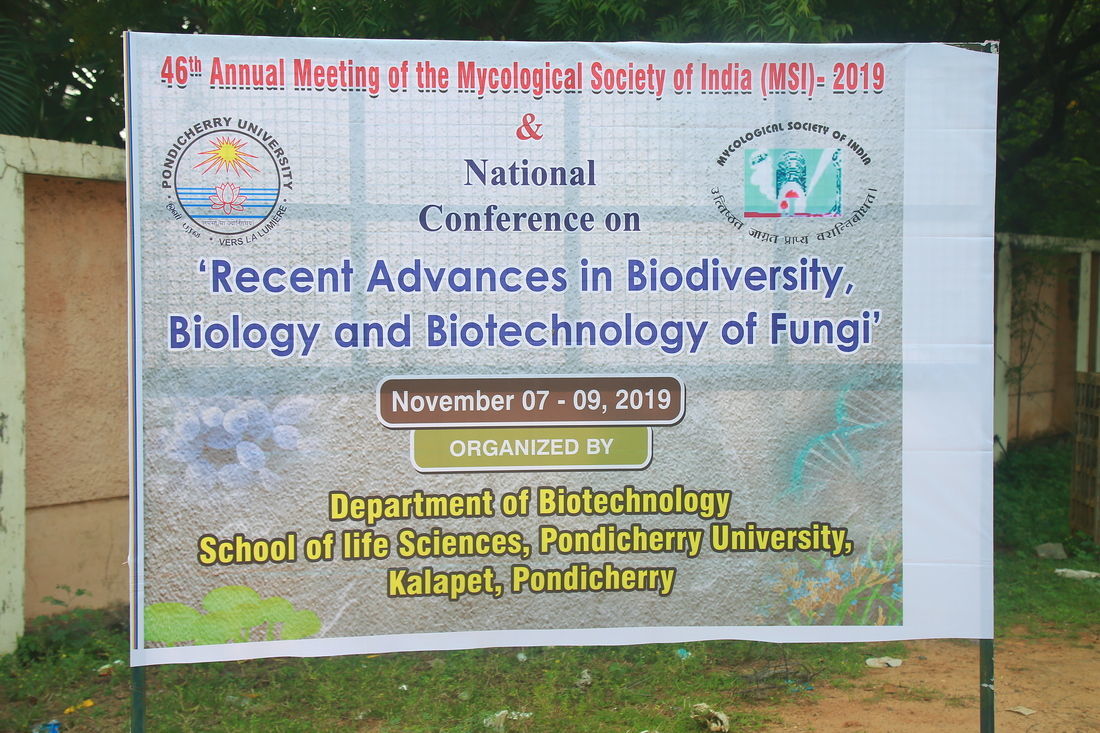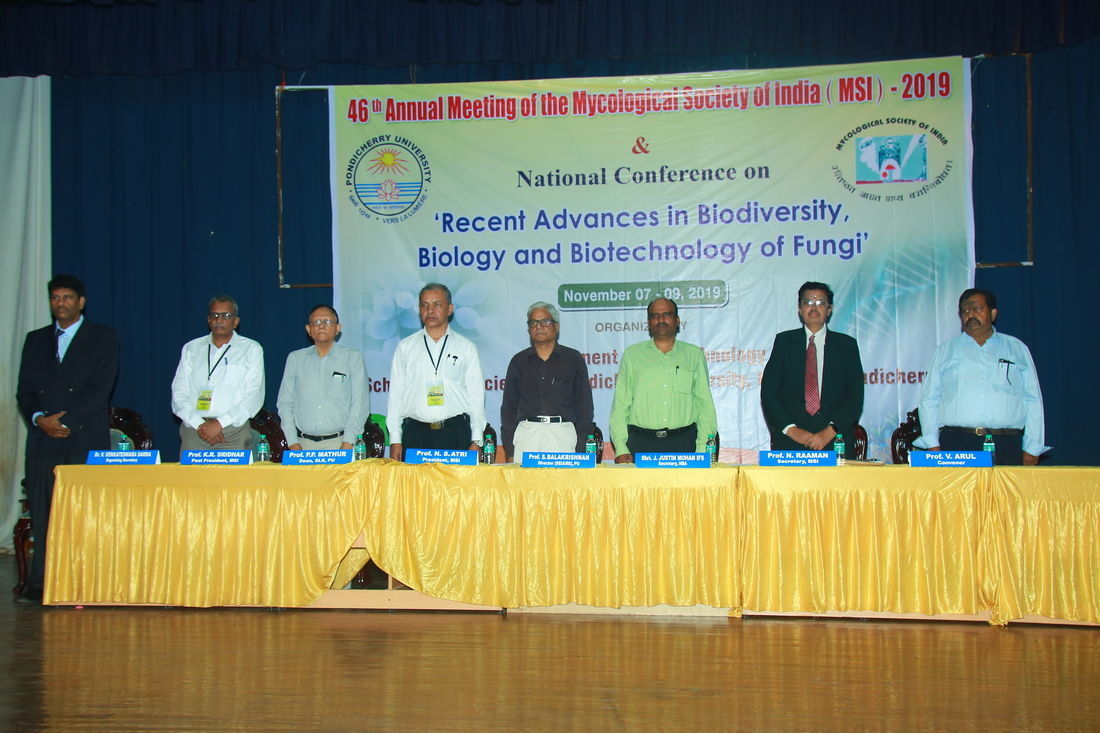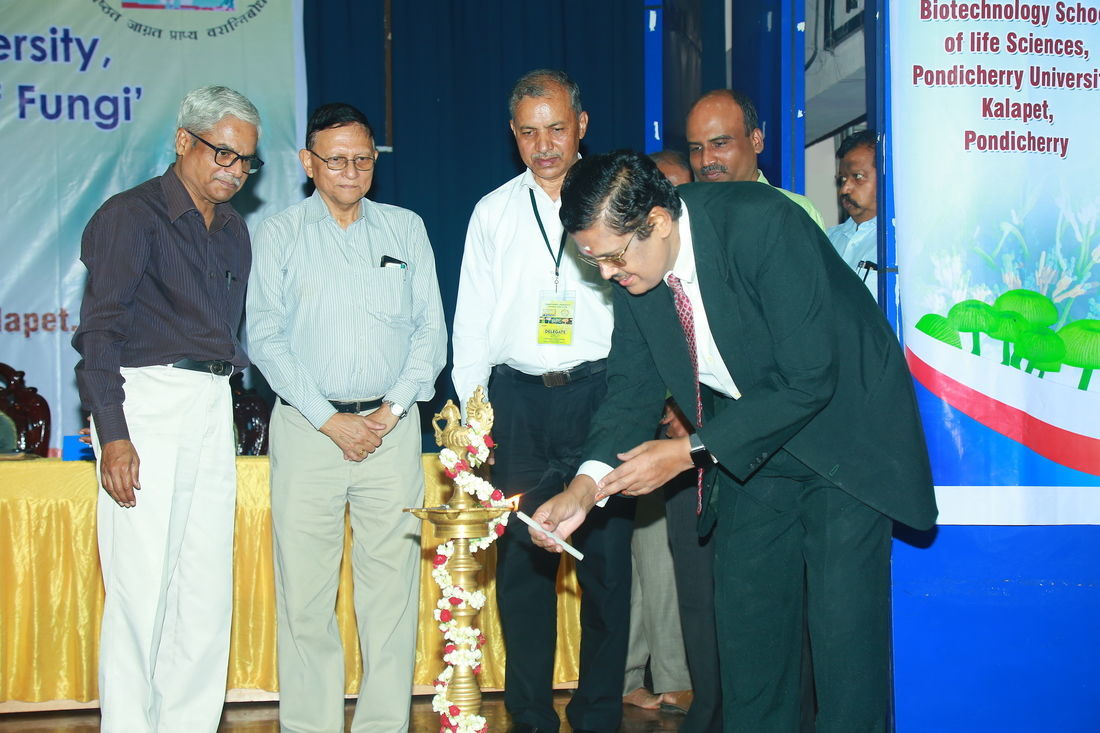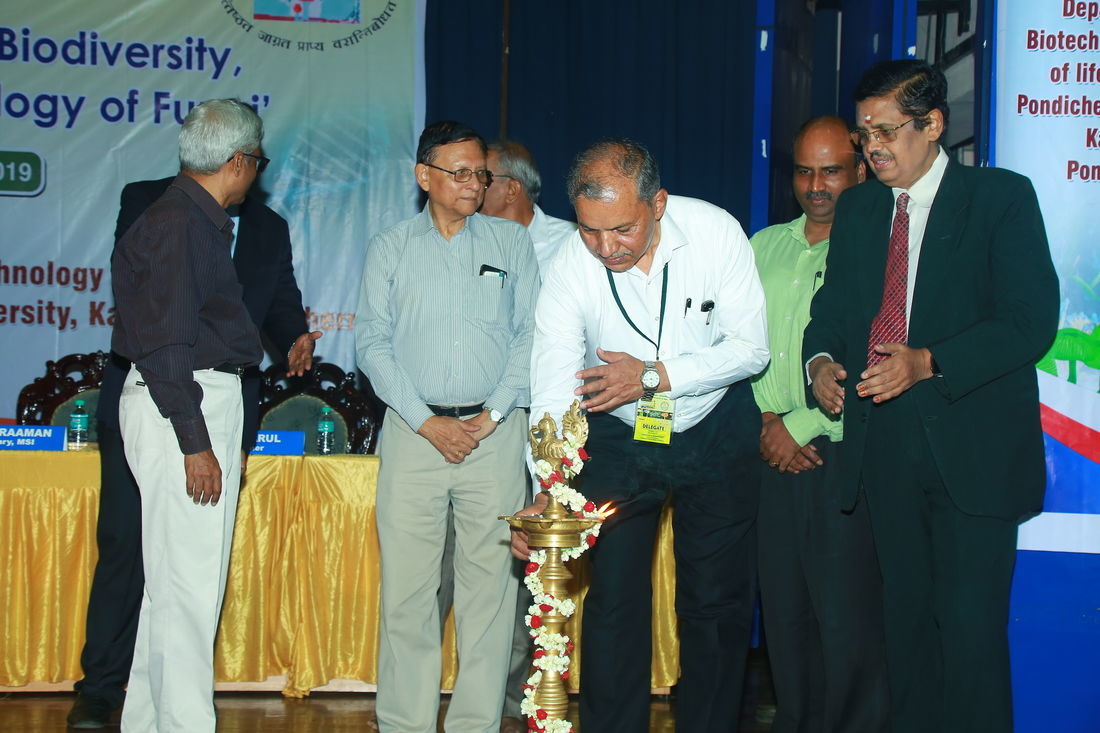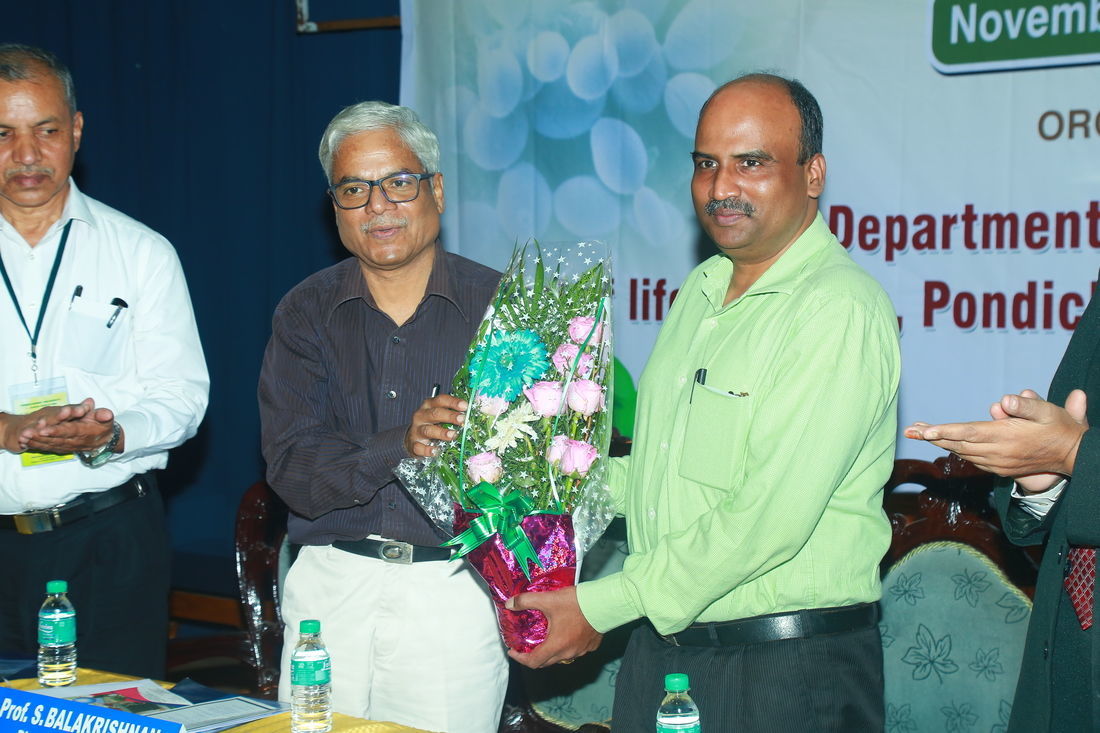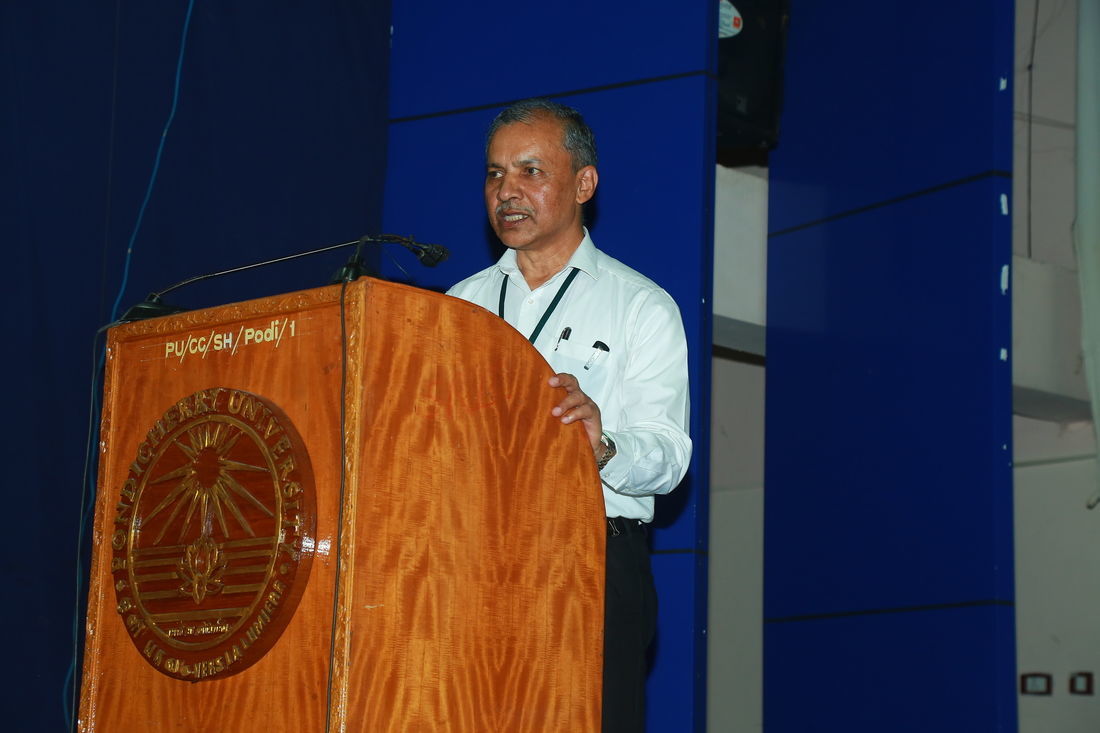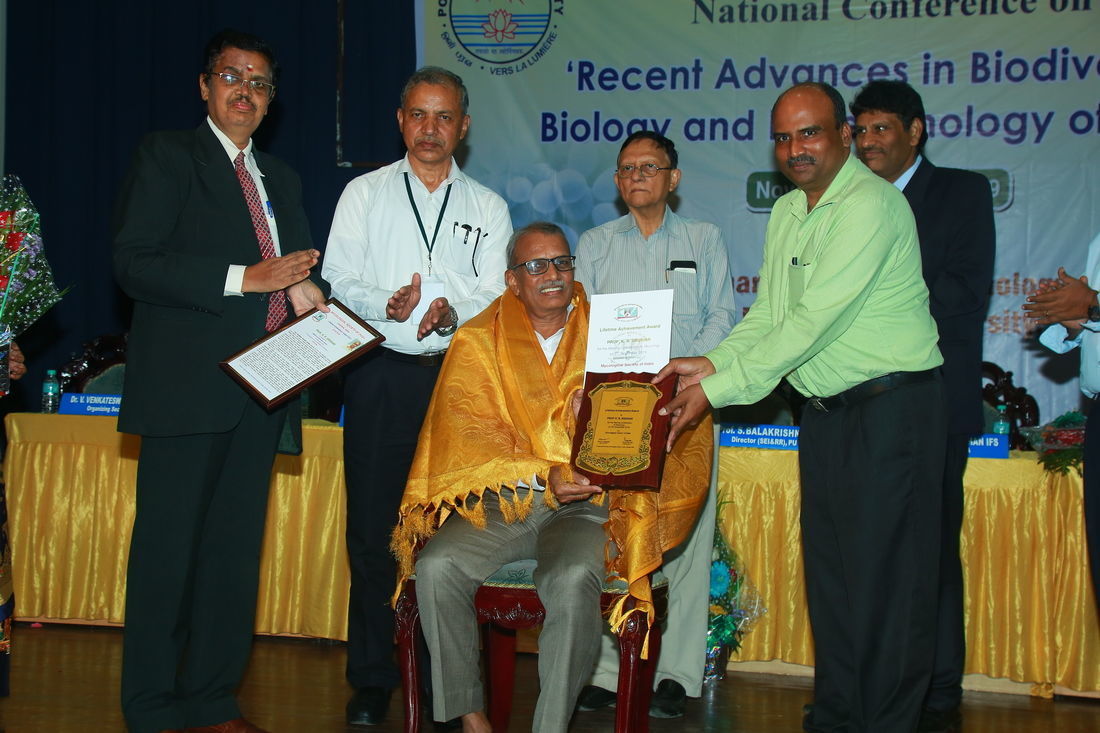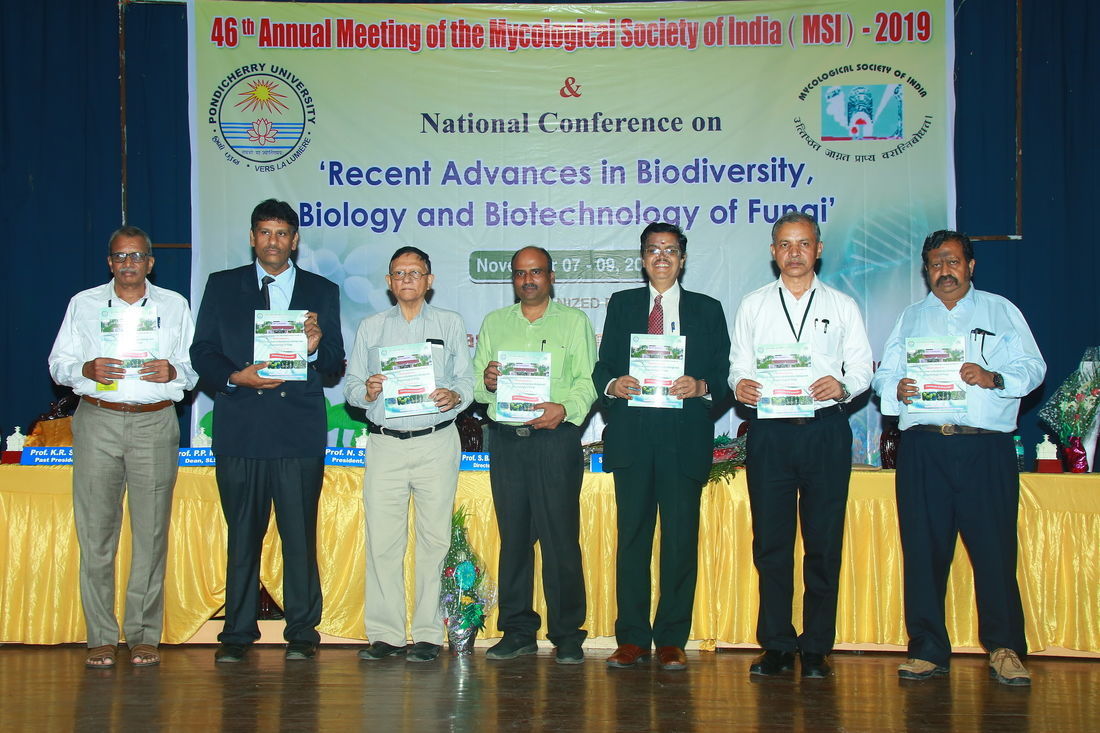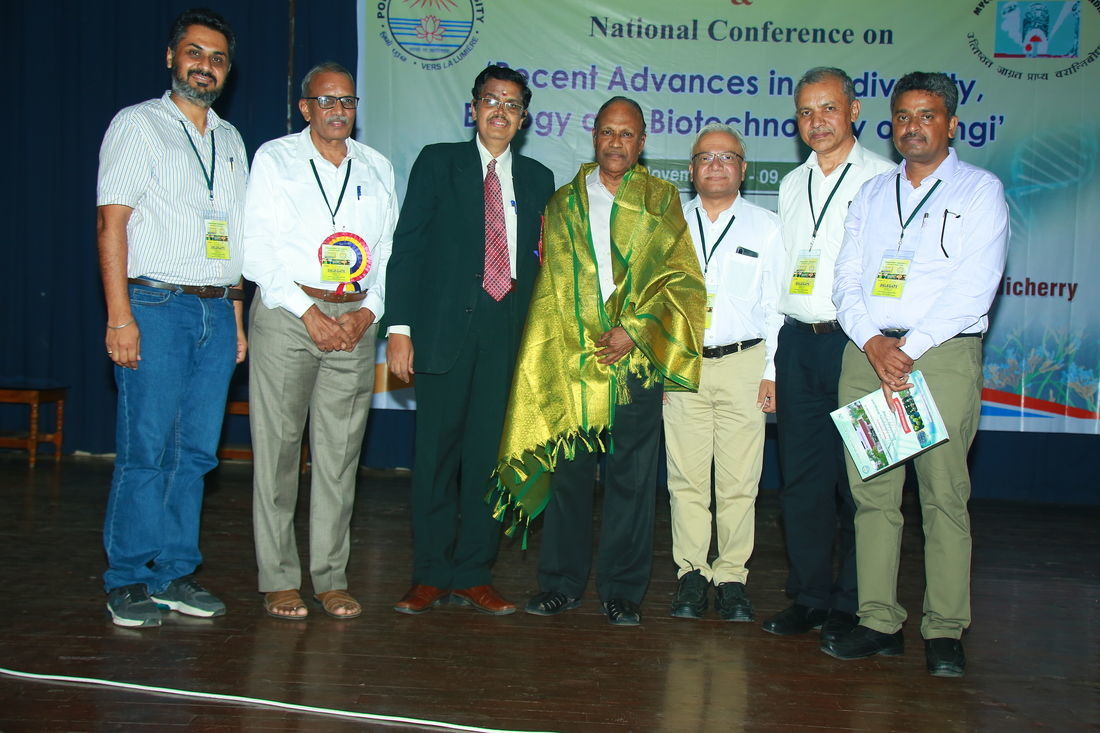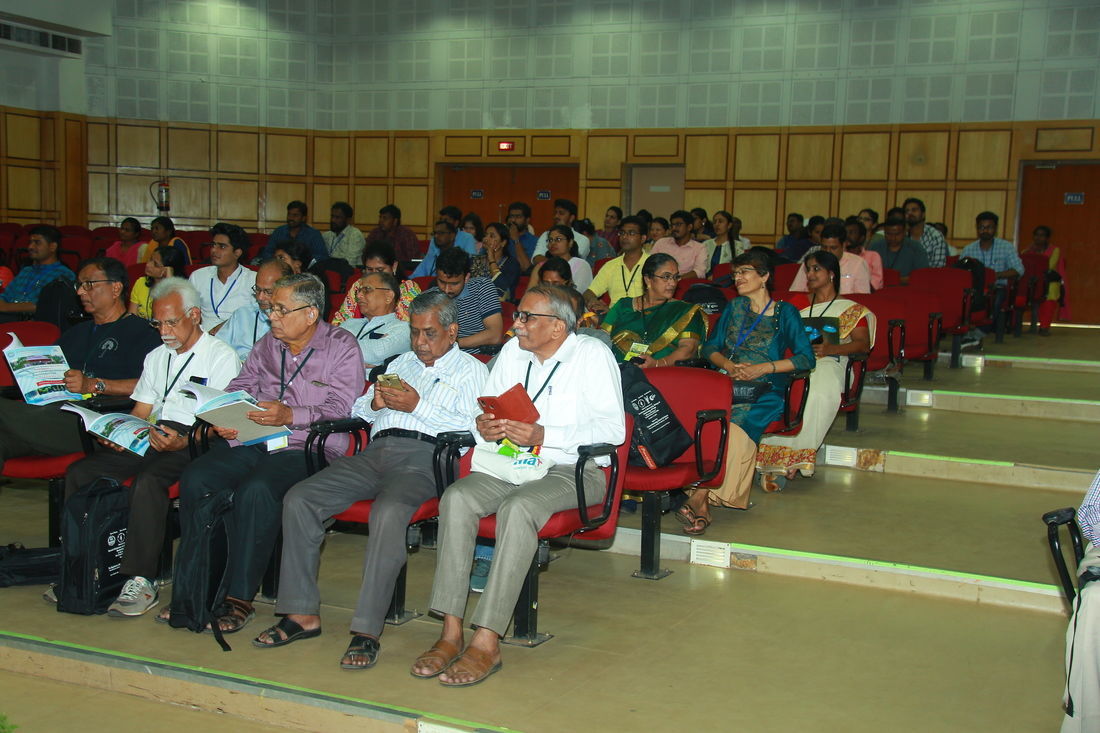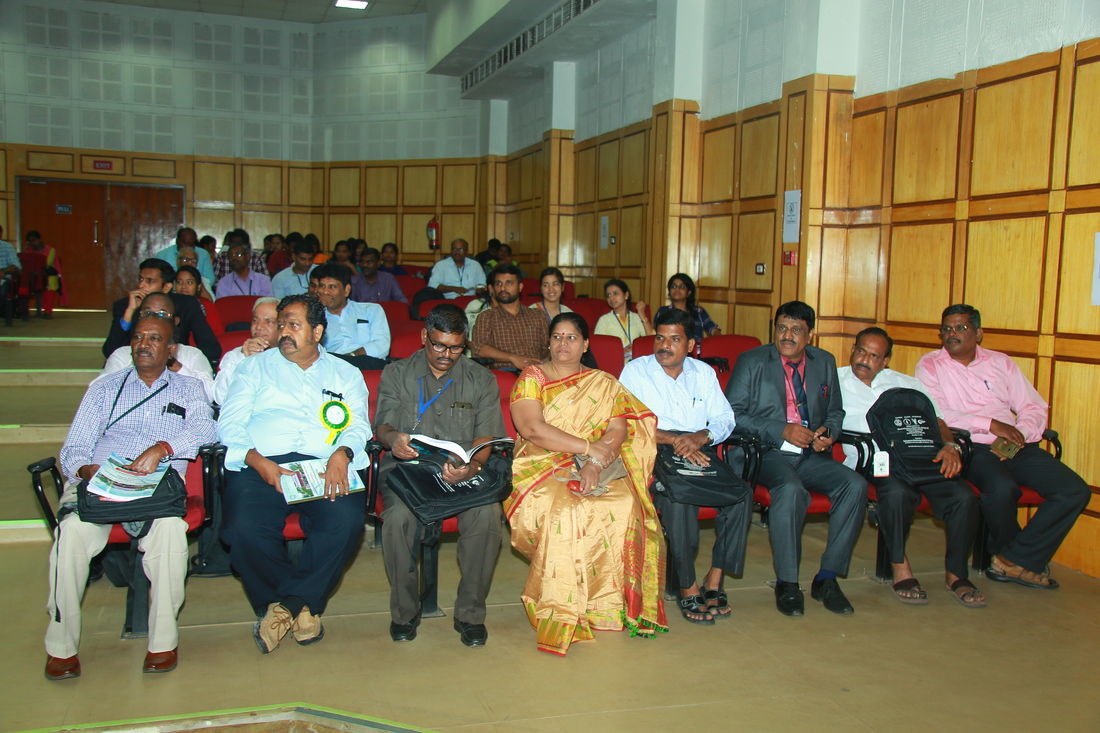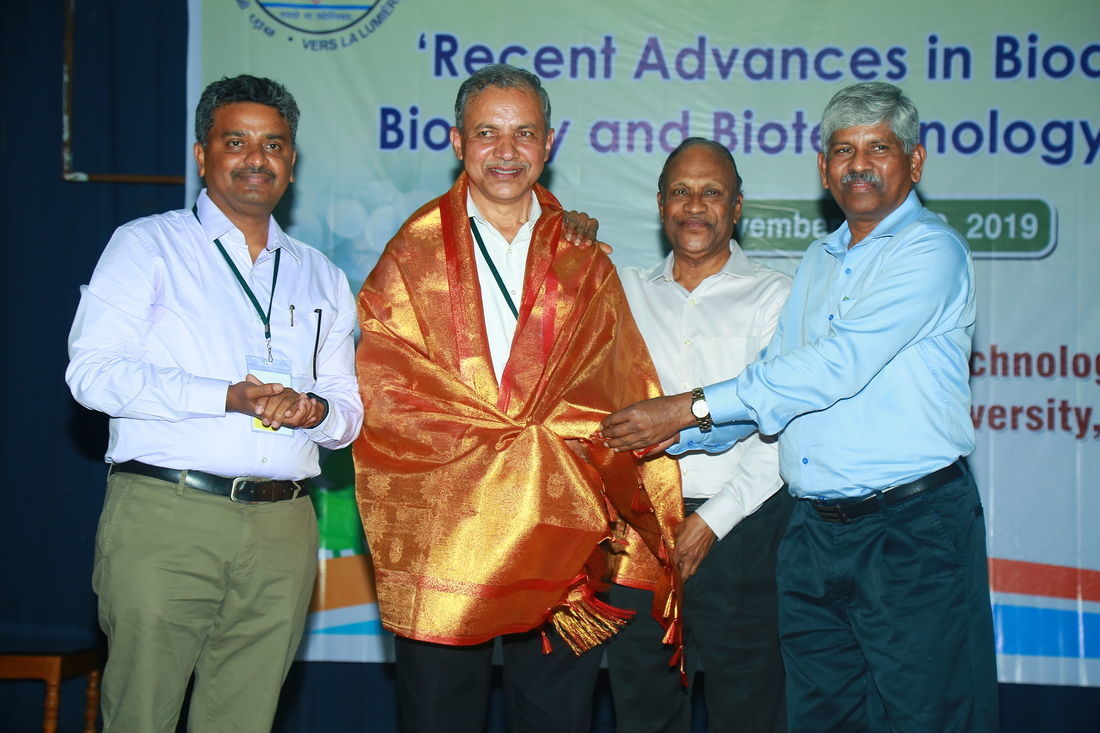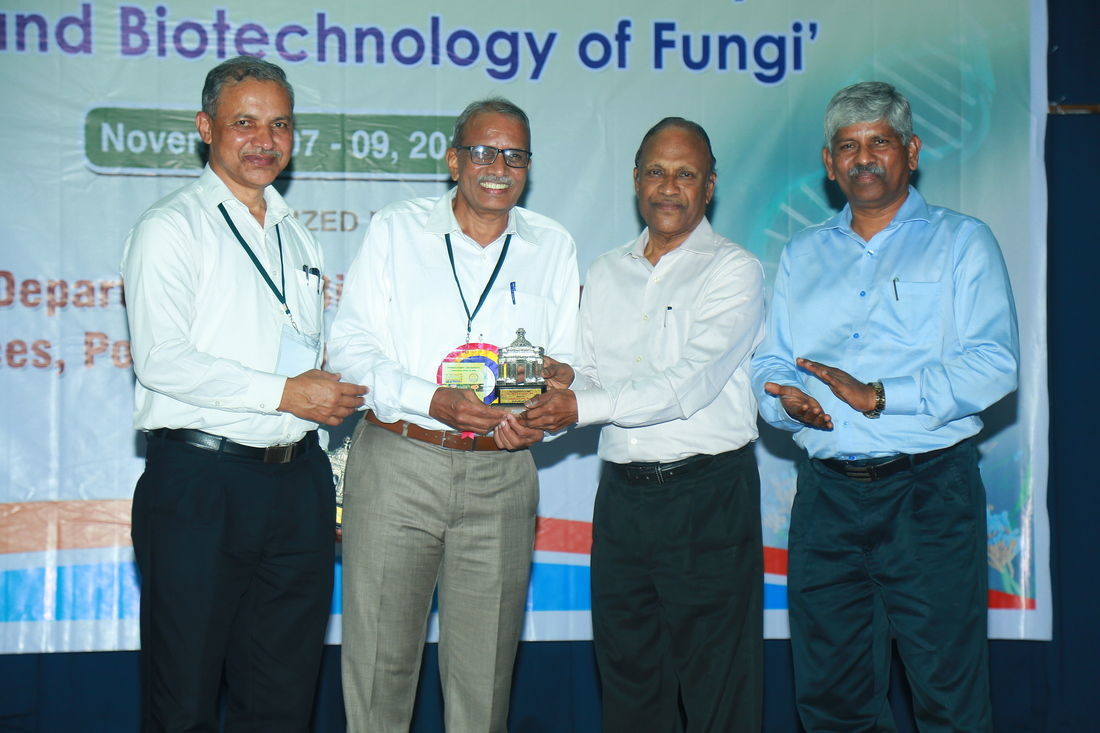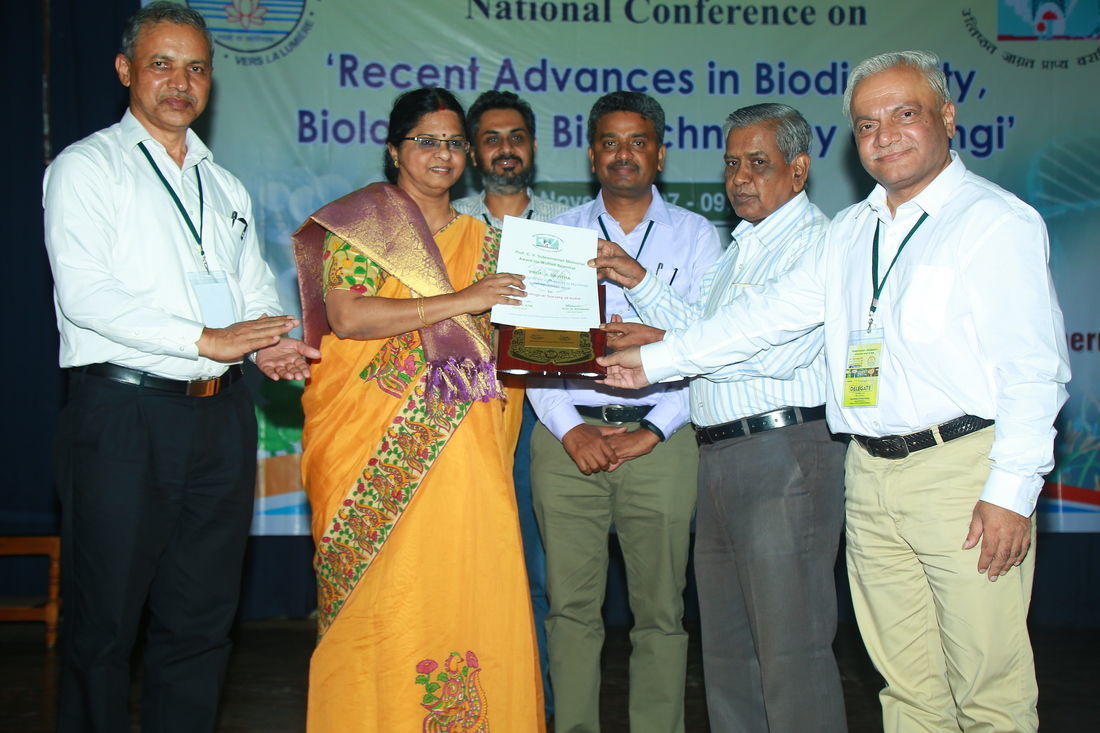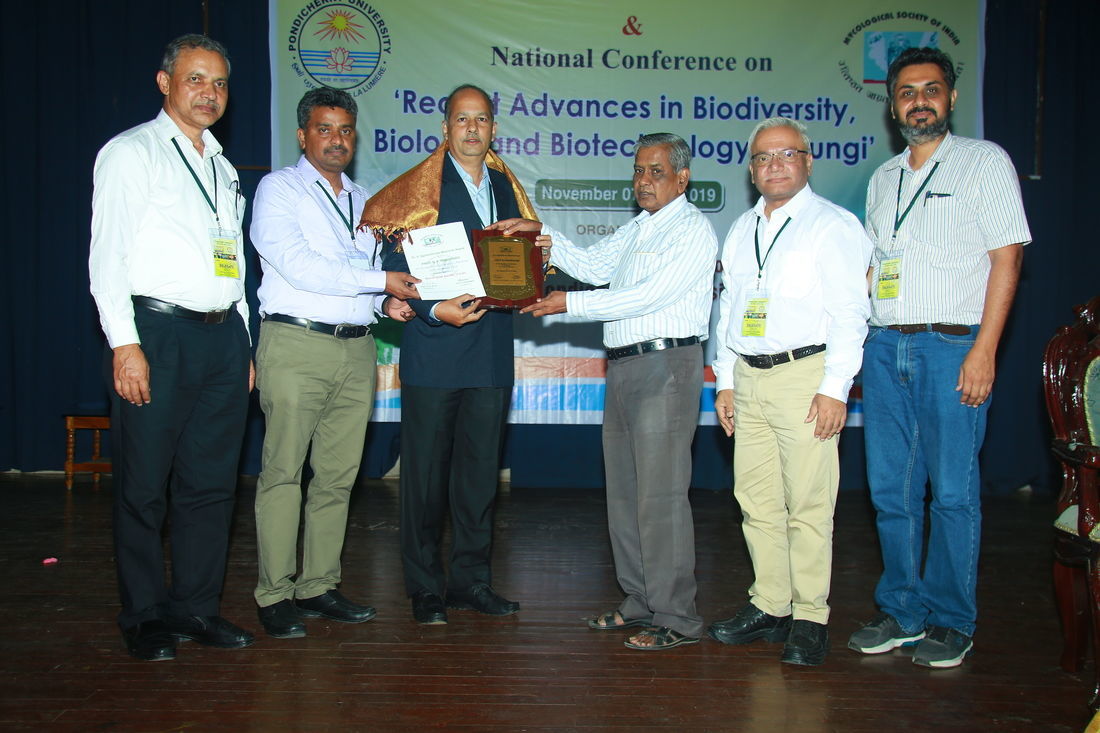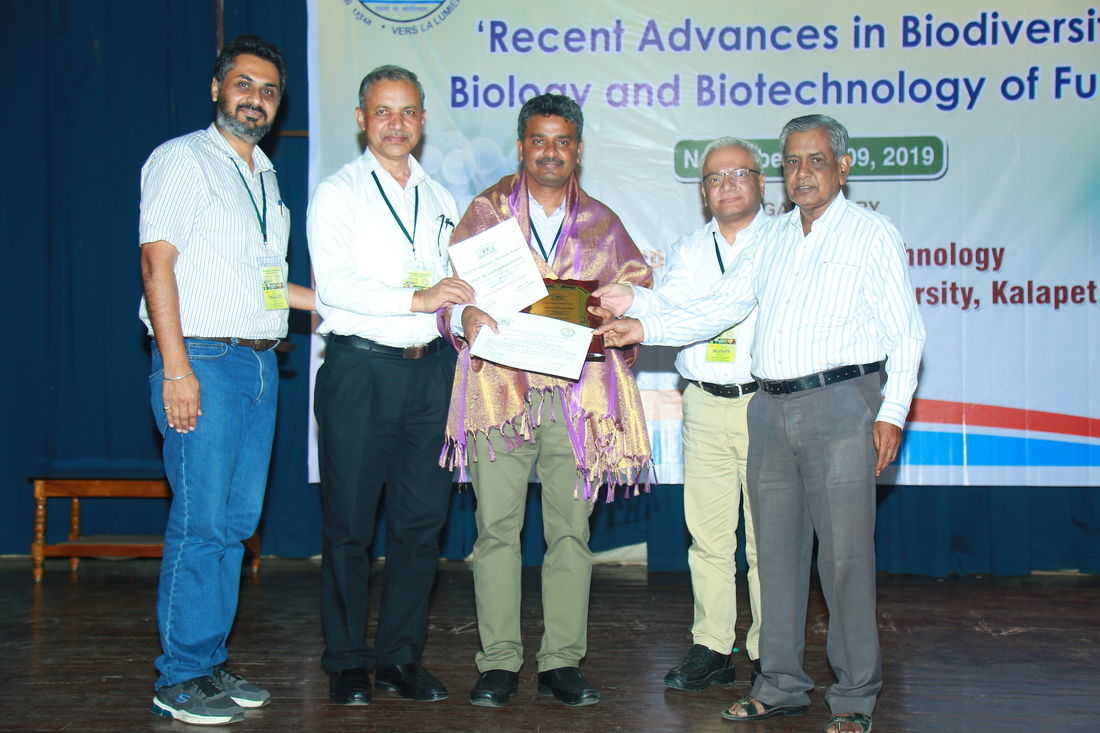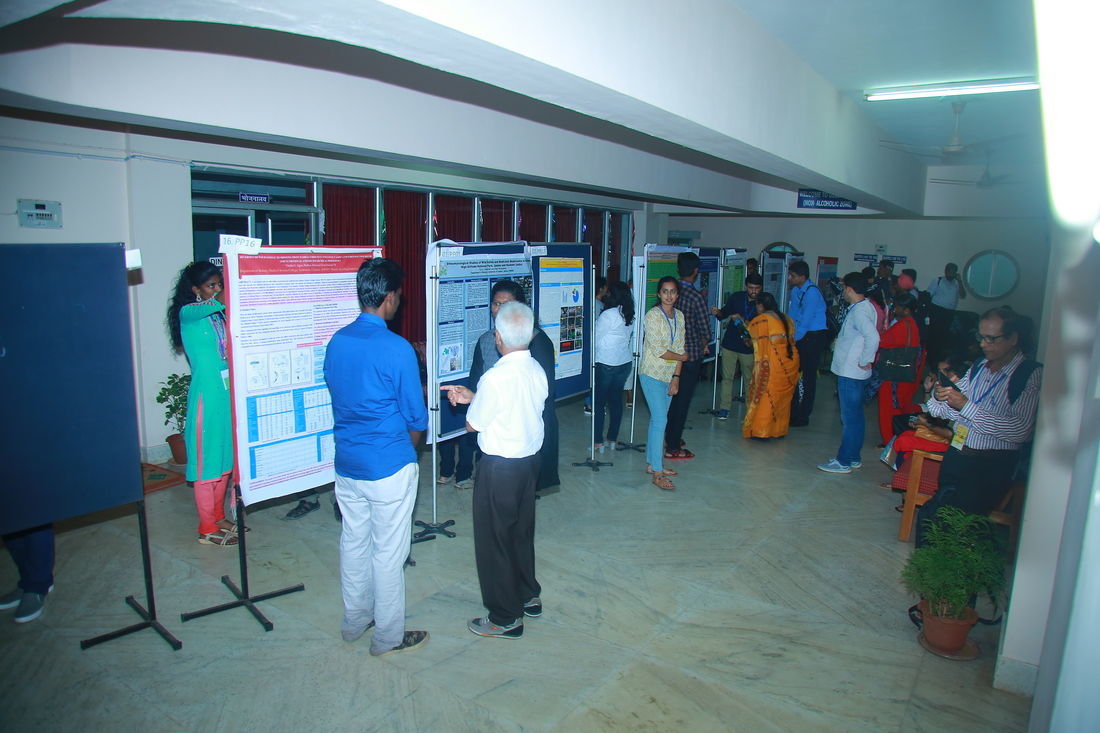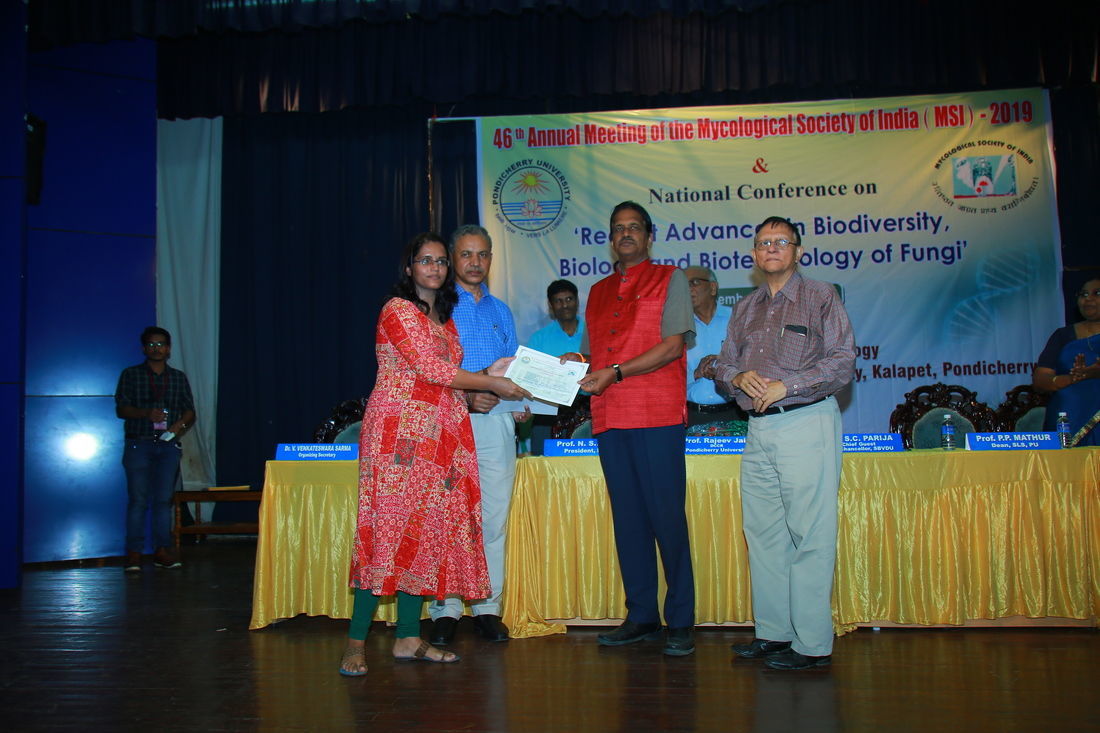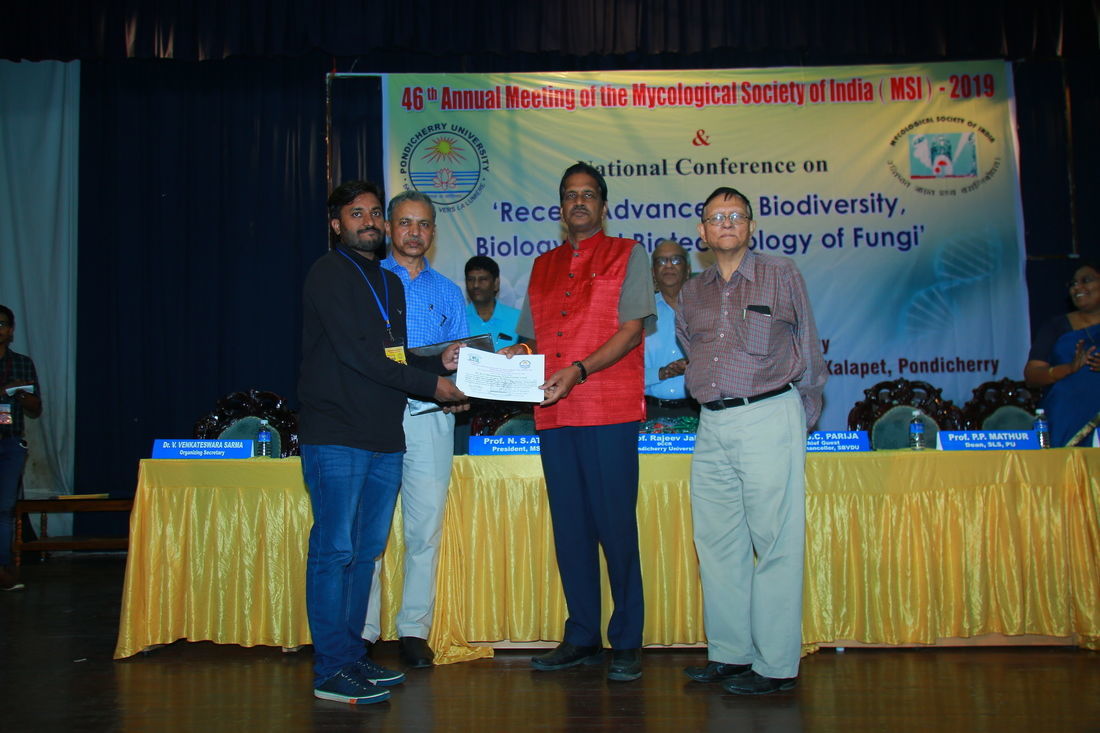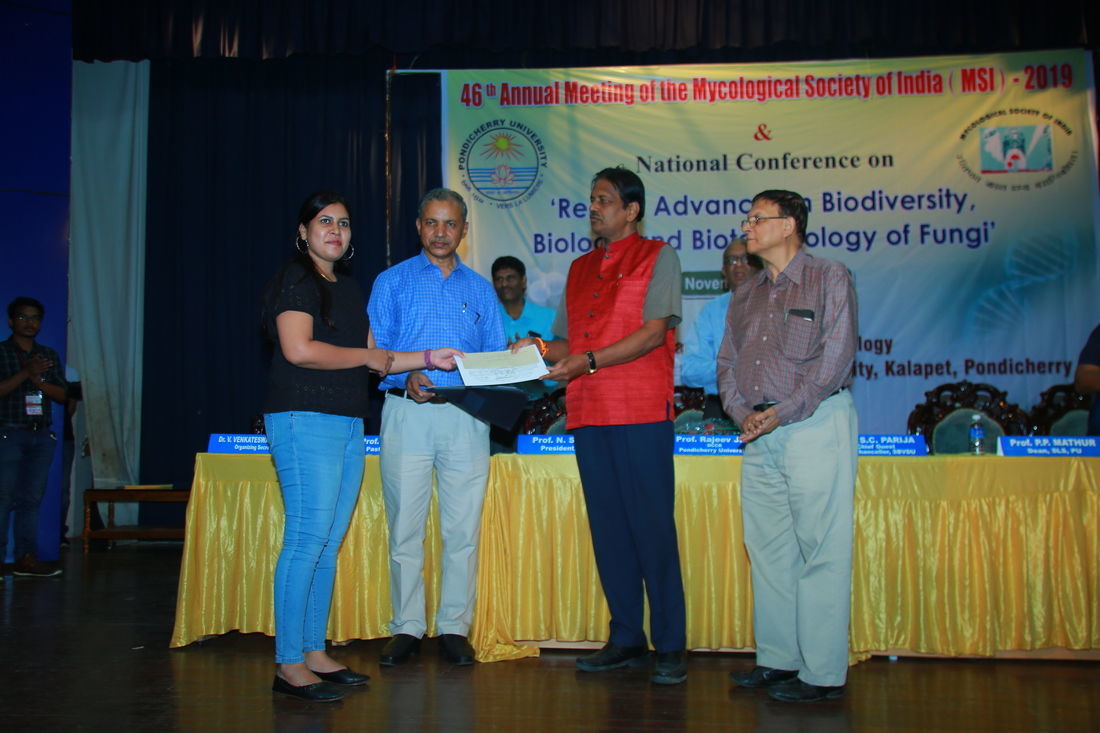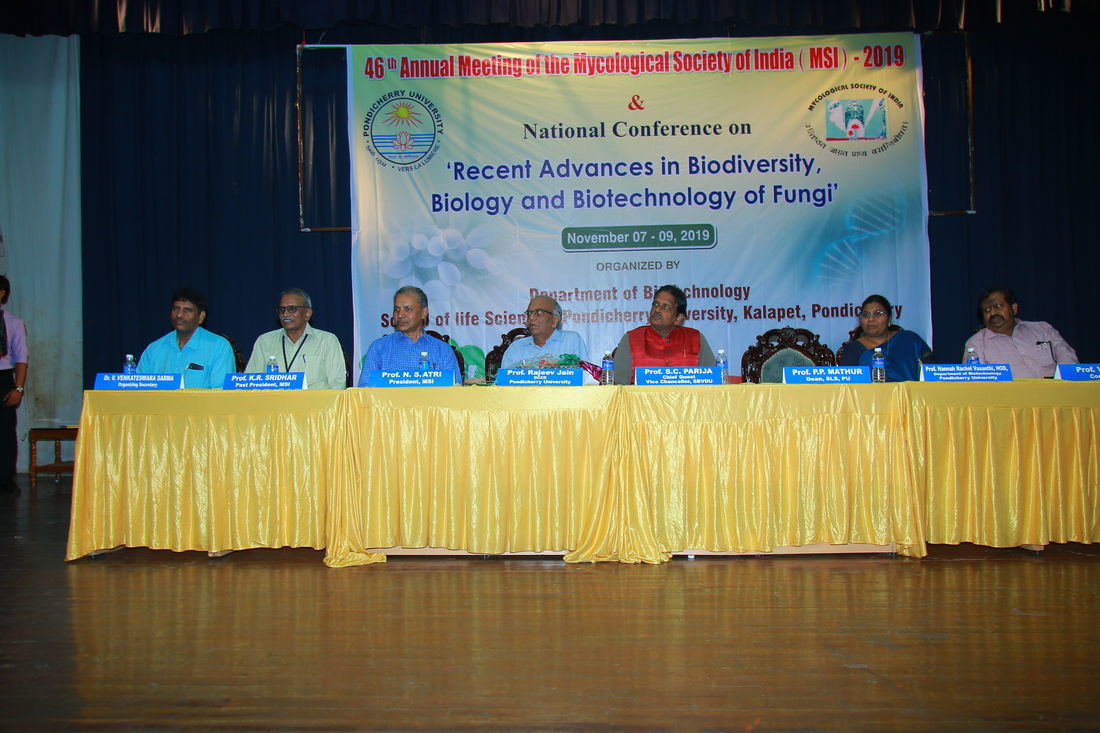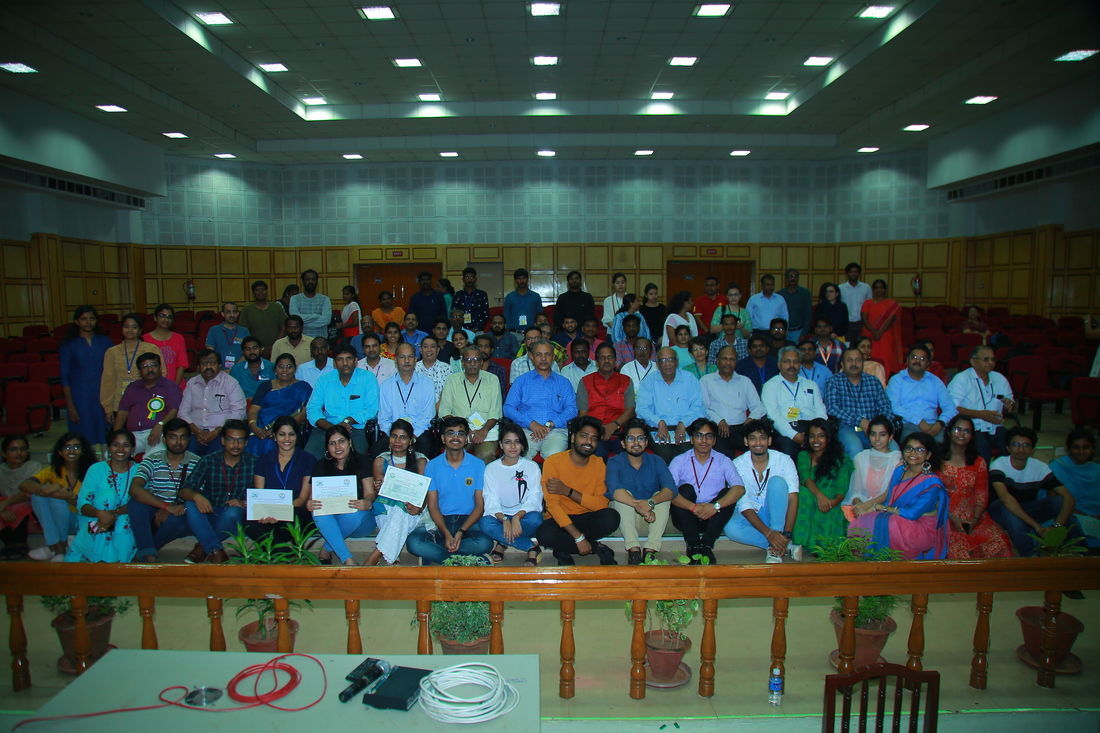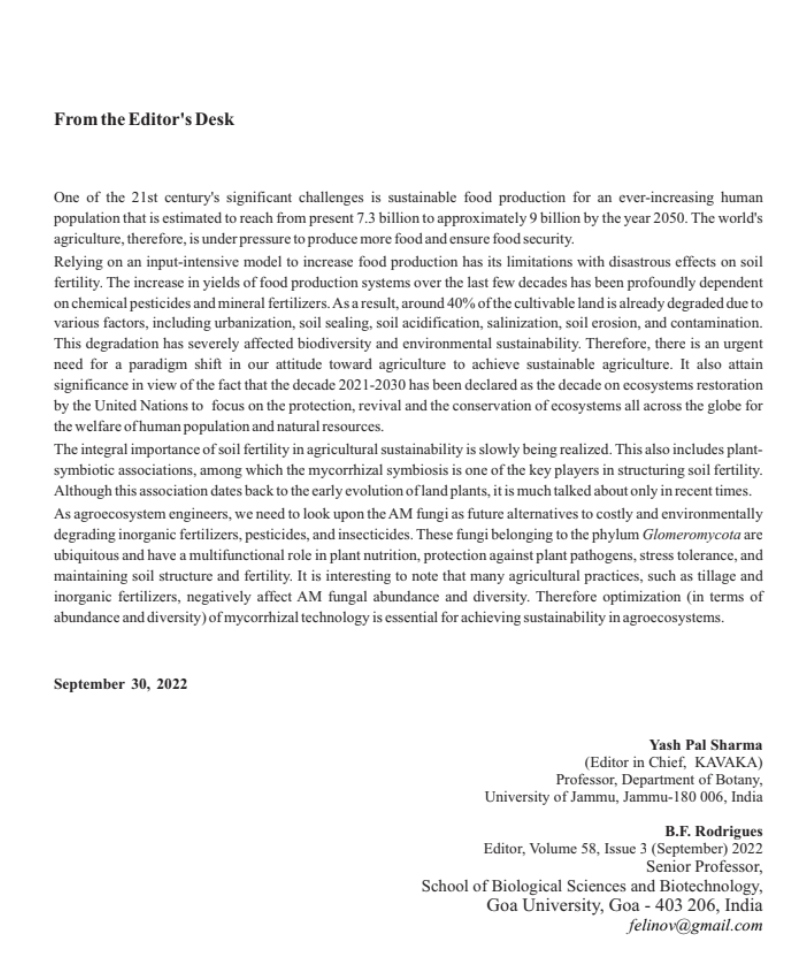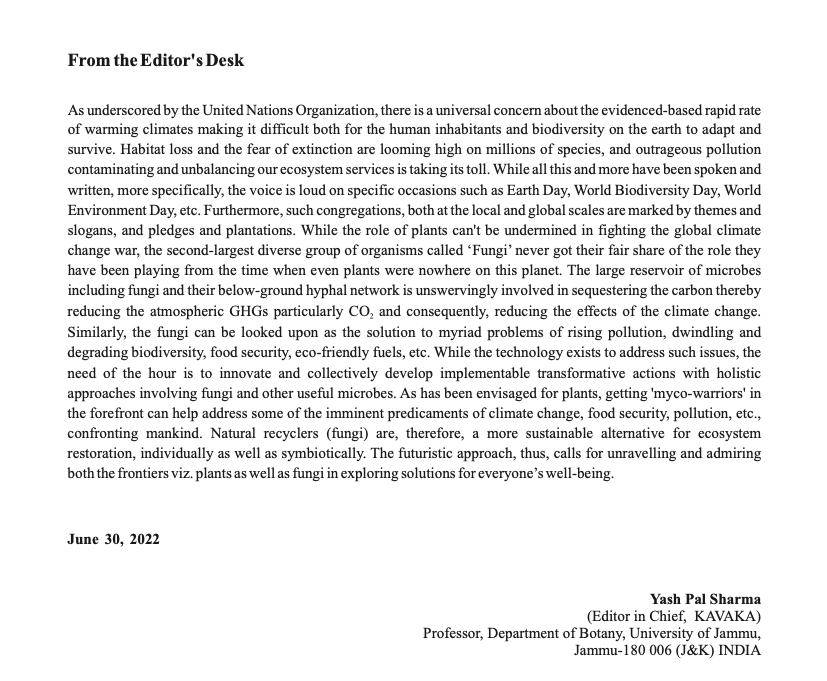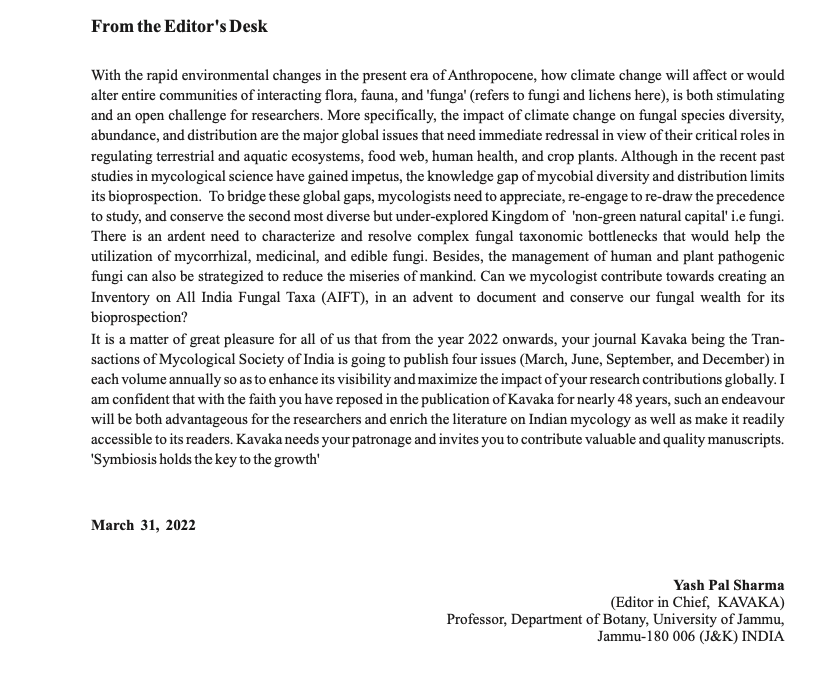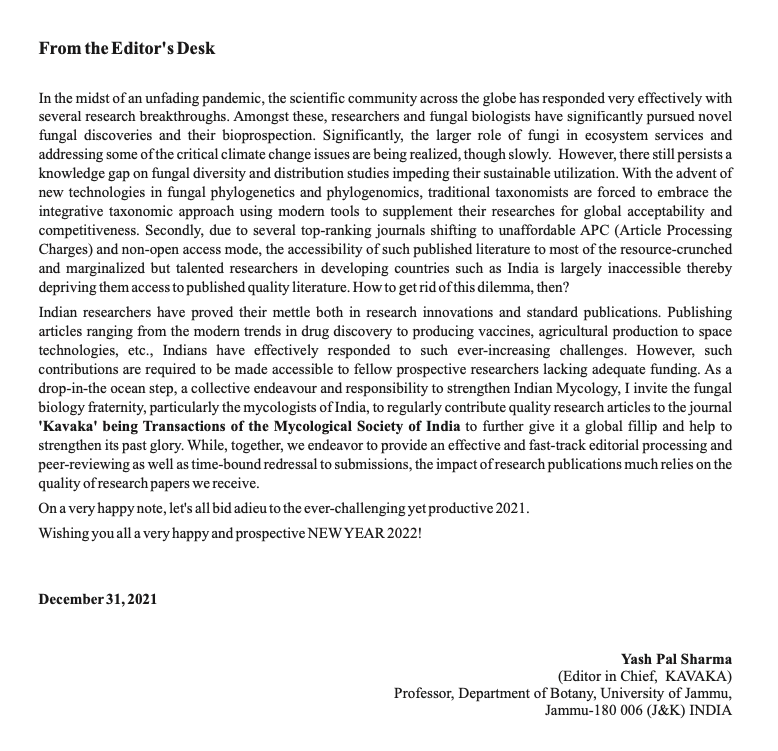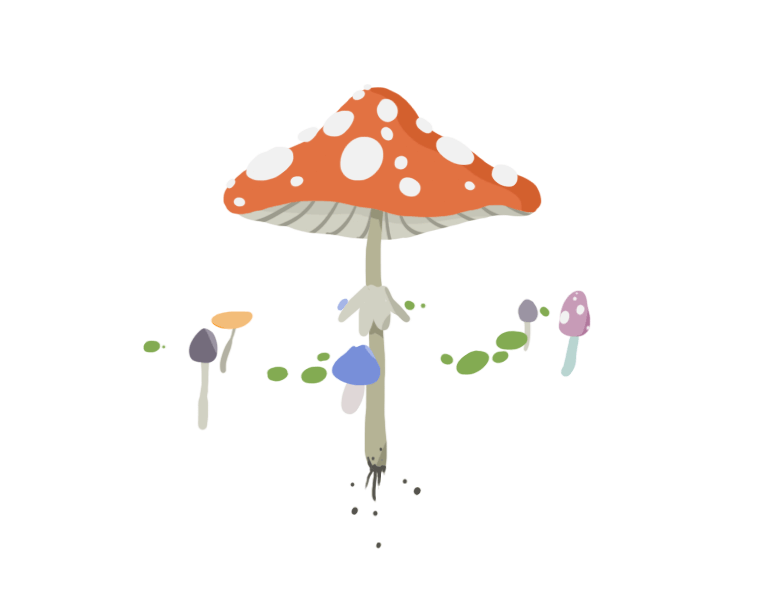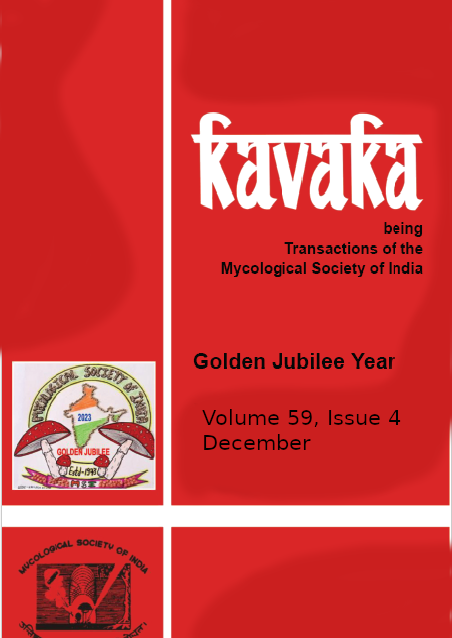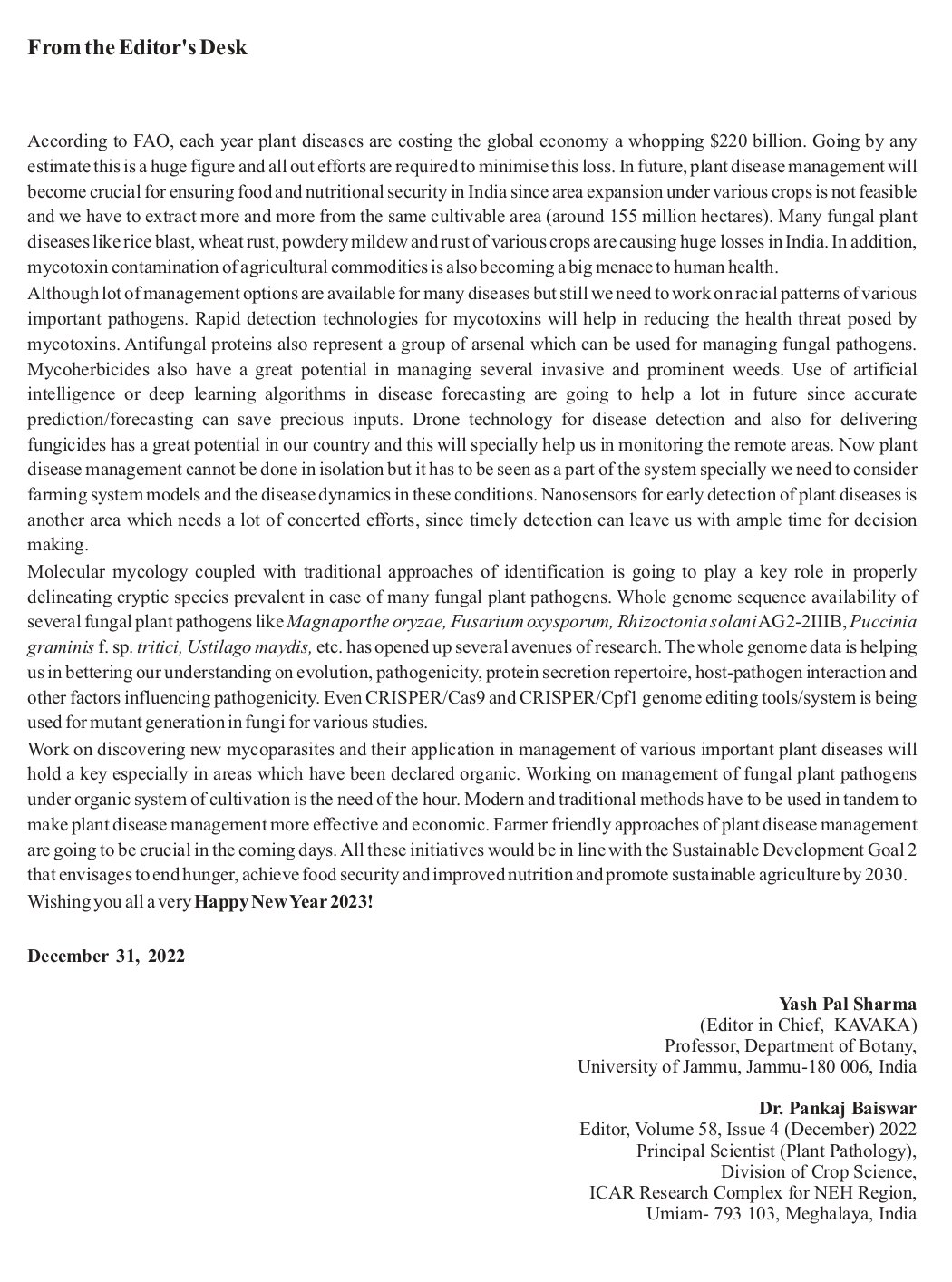
KAVAKA 58 (4): 1-9 (2022) DOI: 10.36460/Kavaka/58/4/2022/1-9 
Understanding onychomycosis - a neglected form of cutaneous mycosis
Geeta Sumbali* and Anjali Sharma
Department of Botany, University of Jammu, BR Ambedkar Road, Jammu-180006 (India) *Corresponding author Email: This email address is being protected from spambots. You need JavaScript enabled to view it.
(Submitted on May 27, 2022; Accepted on October 03, 2022)
ABSTRACT
Onychomycosis refers to the chronic fungal infection of toenails and fingernails that may involve any component of the nail unit. It is the most common nail disorder experienced worldwide and is usually caused by different species of dermatophytes, saprophytic moulds, yeast and yeast-like fungi. Approximately 50-70 per cent of the nail disorders are caused by fungal pathogens, which affect the quality of life by causing pain, discomfort and physical impairment. Moreover, onychomycosis cause psychological and social limitations, which can undermine work and social life of a person. Onychomycosis is mostly caused by keratinophilic fungi, which have the unique ability of degrading keratin that forms the nail apparatus. Structurally, the nail apparatus has certain protective layers, such as, the cuticle and the distal solehorn but it is exposed to the harsh environments and is thus prone to damage and invasion by various keratinophiles through the distal and proximal nail folds. Management of onychomycosis is quite challenging since the infection is embedded within the nail and is difficult to reach. Synthetic antifungal agents are commonly used to control them but they are non-biodegradable, have various side effects due to residual toxicity, long duration of treatment, recurrence of infection and development of resistance to fungal pathogens. All these reasons have led to the exploration of some naturally occurring fungitoxicants like essential oils of higher plants for the management of onychomycotic pathogens
Keywords: Onychomycosis, Nail dystrophies, Dermatophytes, Non-dermatophytic filamentous fungi, Yeast-like fungi
KAVAKA 58 (4): 10-17 (2022) DOI: 10.36460/Kavaka/58/4/2022/10-17 
Eco-fabrication of anti-proliferative fluorescent silver nanoparticles using neem endophytic fungus
Ejaz Ahmad Siddiqui1, Shadab Khan1, Sahrish Arfin1, Shruti Satpute1, Pooja Salunkhe1, Iqbal Siddiqui1, Sk Najrul Islam2, Renuka Bhor3, Jyoti Otageri3, Kalpana Pai3, Narendra Kadoo3, Vidya Gupta3 and Absar Ahmad1,2*
1Division of Biochemical Sciences, CSIR-National Chemical Laboratory, Pune-411008, India 2Interdisciplinary Nanotechnolcogy Centre (INC), Z.H. College of Engineering and Technology, Aligarh Muslim University, AMU, Aligarh, UP-202002, India.
3Department of Zoology, Savitribai Phule Pune University, Pune -411007, India. *Corresponding author Email: This email address is being protected from spambots. You need JavaScript enabled to view it.
(Submitted on September 22, 2022; Accepted on December 14, 2022)
ABSTRACT
Ever since scientists uncovered that plant-associated endophytic fungi have the ability to autonomously generate the same plant-based drugs/bioactive molecules; a multitude of endophytes have been utilized for the same. Extending the above aspect, our group directed it towards employing endophytes instead of plants in the 'eco-fabrication of nanoparticles'. The present manuscript demonstrates one such simple, reliable and ecological approach to the synthesis of biomedically and technologically prized silver nanoparticles (AgNPs) using an endophytic fungus isolated from neem (Azadirachta indica A. Juss.) leaves. Wet mycelial mass of the fungus when added to aqueous precursor silver nitrate (AgNO3) led to the synthesis of profuse amounts of extracellular dispersed, fluorescent, quasi-spherical AgNPs of 20-60 nm having 20 nm average size. The nanoparticles were utterly characterized using recognized standard techniques. Cytotoxic activity of these nanoparticles was examined against human lung cancer cells (A549) and normal human peripheral blood mononuclear cells (PBMC), and it was observed that our AgNPs are anti-proliferative against cancer cells but safe toward normal cells. Furthermore, assessment of toxicity toward human RBCs (erythrocytes) revealed a mere 7% hemolysis in comparison to Triton X-100, consequently confirming the safe nature of our nanoparticles on human cells. Also, we scrutinized the anti-microbial potency of our biofabricated AgNPs and found them to be anti-microbial against different fungal (Aspergillus niger) and bacterial [Gram positive (Bacillus subtilis & Staphylococcus aureus), Gram negative (Pseudomonas aeruginosa)] strains. These multi-faceted nanoparticles will find broad spectrum applications in fields like drug/targeted delivery, therapeutics, theranostics, anti- microbial coatings, and so on
Keywords: Anti-microbial, Anti-proliferative, Eco-fabrication, Endophyte, Neem, Silver nanoparticles
KAVAKA 58 (4): 18-23 (2022) DOI: 10.36460/Kavaka/58/4/2022/18-23 
Morphological and phylogenetic characterisation of two species of family Russulaceae from Jammu and Kashmir, India
Komal Verma1, Faisal Mushtaq2, Anil Kumar1 and Yash Pal Sharma1*
1Department of Botany, University of Jammu, Jammu, Jammu and Kashmir, India. 2Department of Botany, Lovely Professional University, Punjab, 144001, India. *Corresponding author Email: This email address is being protected from spambots. You need JavaScript enabled to view it.
(Submitted on August 17, 2022; Accepted on November 03, 2022)
ABSTRACT
In the present paper two species of family Russulaceae i.e., Lactarius abieticola and Russula lakhanpalii are reported for the first time from Jammu and Kashmir, India. Russula lakhanpalii belongs to subgenus Heterophyllidia of genus Russula and Lactarius abieticola belongs to subg. Lactarius of genus Lactarius. A detailed macro- and micromorphological descriptions coupled with the illustrations and nrITS-based molecular analyses are presented here.
Keywords: Macrofungi, nrITS, Phylogeny, Regional records
KAVAKA 58 (4): 24-27 (2022) DOI: 10.36460/Kavaka/58/4/2022/24-27 
Effect of native rice specific isolates of Trichoderma and ecological fitness against aggregated sheath spot of rice caused by Ceratorhiza oryzae-sativae
Konjengbam Sarda Devi1*, Kota Chakrapani1, Wangkhem Tampakleima Chanu1, Bijeeta Thangjam1, Bireswar Sinha1, Laikangbam Nongdrenkhomba1, Ph. Sobita Devi1 and Akoijam Ratankumar Singh2
1Department of Plant Pathology, College of Agriculture, Central Agricultural University (Imphal), Iroisemba- 795 004, Imphal West, Manipur, India
2ICAR Research Complex for North Eastern Hill Region, Manipur Centre, Lamphelpat, Imphal West-795 004, Manipur, India
*Corresponding author Email: This email address is being protected from spambots. You need JavaScript enabled to view it.
(Submitted on October 05, 2022; Accepted on December 06, 2022)
ABSTRACT
Trichoderma is a free-living fungus that interacts heavily with its surroundings found in the root, soil, and foliar regions of plants as well. It is an important biocontrol agent due to its abilities, such as mycoparasitism, production of antibiotic, hydrolytic enzymes, competition for nutrients, as well as induced plant resistance; production of numerous secondary metabolites inhibiting the growth of several plant pathogens. Antagonistic potential of fourteen (n=14) native rice specific Trichoderma isolates was evaluated against aggregated sheath spot of rice caused by Ceratorhiza oryzae-sativae. It revealed that all native Trichoderma isolates significantly inhibited the mycelial growth of the pathogen of C. oryzae-sativae with ranges from 71.50% to 97.50% with the highest per cent inhibition by T. harzianum (MH257323), and the least percent inhibition by T. koningiopsis (MN080228). Bell's scale studied showed that class III category by T. koningiopsis (MN080228) and class II showed by T. harzianum (MH257323) against C. oryzae-sativae. Among isolates of native rice specific T. harzianum, MH257323 is found to be the most effective in reducing the rapid growth of pathogen and having high potential ecological fitness.
Keywords: Aggregated sheath spot, Biocontrol agent, Ecological fitness, Mycoparasitism, Rice, Trichoderma
KAVAKA 58 (4): 28-35 (2022) DOI: 10.36460/Kavaka/58/4/2022/28-35 
Effect of AM fungus on phosphorus nutrition of maize and pigeon pea in alfisols as influenced by different phosphorus amendments of North Carolina Rock Phosphate (NCRP)
R. Mythra*, G.S. Srikanth., U. Jagadeesh, K.B. Bhagyashree and A. Manjunath
Department of Agricultural Microbiology, GKVK, University of Agricultural Sciences, Bengaluru, Karnataka, India
*Corresponding author Email: This email address is being protected from spambots. You need JavaScript enabled to view it.
(Submitted on September 19, 2022; Accepted on November 30, 2022)
ABSTRACT
A greenhouse investigation was conducted to determine the effect of AM fungus on phosphorus nutrition of maize and pigeon pea in alfisols as influenced by different phosphorus amendments of North Carolina Rock Phosphate (NCRP). This experiment consisted of 24 treatments resulting from factorial combination of two plant species, two levels of AM fungal (Glomus aggregatum) inoculation and six levels of phosphorus amendments. The extent of mycorrhizal fungal colonization in roots of pigeon pea was higher than that of maize. Inoculation of soil with AM mycorrhizal fungus caused significant increase in total phosphorus uptake of pigeon pea as well as maize. The extent of increase in total phosphorus uptake due to mycorrhizal inoculation in pigeon pea was higher than maize. The phosphorus uptake efficiency of maize was lower than pigeon pea. Mycorrhizal colonization significantly reduced phosphorus utilization efficiency of both plant species. The results of this study suggest that application of NCRP bio-acidulated with Bacillus sp. and Penicillium sp. improves phosphorus nutrition of maize and pigeon pea and inoculation of soil with AM fungus increase that effect.
Keywords: AM fungi, NCRP, Glomus aggregatum, Bacillus sp., Penicillium sp., Phosphorus nutrition.
KAVAKA 58 (4): 36-39 (2022) DOI: 10.36460/Kavaka/58/4/2022/36-39 
Efficacy of fungicides and endophytic bacteria against Fusarium wilt of chickpea caused by Fusarium oxysporum f. sp. ciceris under in vitro conditions
Kailash Patel1*, R.K. Tombisana Devi1, A. Ratankumar Singh2, Kennedy Ningthoujam1, Veronica Kadam1 and Sushanti Thokchom1
1School of Crop Protection, College of Post Graduate Studies in Agricultural Sciences, CAU(I), Umiam-793103, Meghalaya, India
2Division of Crop Science, ICAR Complex for North Eastern Hill Region, Umiam-793 103, Meghalaya, India
*Corresponding author Email: This email address is being protected from spambots. You need JavaScript enabled to view it.
(Submitted on October 08, 2022; Accepted on December 09, 2022)
ABSTRACT
Chickpea (Cicer arietinum L.) is an important leguminous crop originated from Southwestern Asia region and Fusarium wilt disease caused by Fusarium oxysporum f. sp. ciceris (Foc) is limiting factor in chickpea cultivation. Efficacy of fungicides and endophytic beneficial bacteria were tested in vitro against chickpea wilt pathogen. Four different fungicides namely, carbendazim 50% WP (bavistin), hexaconazole 5% EC (contaf plus), propiconazole 25% EC (Tilt) and thiophanate methyl 70% WP (Roko) at 0.10, 0.15 and 0.20% were evaluated in vitro against Fusarium wilt of chickpea. Carbendazim and propiconazole proved the most effective exhibiting mean mycelial growth inhibition of 100% at all concentrations followed by hexaconazole and thiophanate methyl inhibit mycelial growth of 78.35 and 77.25% at 0.20% respectively. Four endophytic bacterial strains of Bacillus designated as ECP1 (Bacillus cereus), ECP5 (Bacillus subtilis), ECP8 (Bacillus amyloliquefaciens) and ECP10 (Bacillus cereus) were also evaluated against the Foc. The endophytic Bacillus strains revealed that ECP1 is the most efficacious resulted in 69.62 % mean inhibition of mycelial growth followed by ECP5 with 67.03%. ECP8 (Bacillus amyloliquefaciens) and ECP10 (Bacillus cereus) showed 65.18% growth reduction over control respectively.
Keywords: Bacillus, Chickpea, Endophytes, Fungicides, Fusarium oxysporum f. sp. ciceris
KAVAKA 58 (4): 40-46 (2022) DOI: 10.36460/Kavaka/58/4/2022/40-46 
Fungal pathogens as potential mycoherbicides to control water hyacinth (Eichhornia crassipes)
K.R. Aneja
Department of Microbiology, Kurukshetra University, Kurukshetra, Haryana 136 119, India Corresponding author Email: This email address is being protected from spambots. You need JavaScript enabled to view it.
(Submitted on July 12, 2022; Accepted on October 18, 2022)
ABSTRACT
Water hyacinth (Eichhornia crassipes), a free-floating aquatic weed and native of Amazon River, is one of the fastest growing plants whose seeds can remains viable for more than 28 years in the mud. Controlling methods for water hyacinth include physical, chemical and biological, but biological using fungal pathogens and/or insects or both as a consortium is effective and eco-friendly. The world of fungi provides a fascinating and almost endless source of biological diversity, which is a rich source for exploitation. Studies conducted on fungal diversity of water hyacinth yielded 21 fungal pathogens, of these two: Fusarium chlamydosporum and Bipolaris sorokiniana recorded for the first time on this weed globally and 7 fungal pathogens [Alternaria alternata isolate-1 and isolate-2 (AL-14), Cercospora rodmanii, Phoma sorghina, Epicoccum nigrum, Acremonium sp., Alternaria sp. and Stemphylium sp.] identified as new records for the country. Biocontrol studies conducted on seven fungal pathogens showed maximum biocontrol efficacy in Cercospora rodmanii (95.3%), followed by Alternaria eichhorniae (80%) and A. alternata (45-72%), revealing all the desired characteristics, such as: can be easily cultured and maintained on natural host, host -specific, easily disseminated and can be mass produced in a short span of time. Moreover, the phylloplane microflora is not antagonistic to these pathogens, thus the biocontrol efficacy would not be affected by the surface microflora. They have the potential to be developed as a mycoherbicide/s either alone or as a consortium to manage water hyacinth worldwide either used alone or in combination with insects and or herbicide.
Keywords: Water hyacinth, Bioherbicides, Alternaria alternata, A. eichhorniae, Fusarium chlamydosporum, Epicoccum nigrum, Cercospora rodmanii
KAVAKA 58 (4): 47-50 (2022) DOI: 10.36460/Kavaka/58/4/2022/47-50 
New records of lichens (Lichenized Ascomycota) from India with novel habitat preferences
Rajesh Bajpai1,2*, Ramya Ranjan Paul2, Chandra Prakash Singh3, Anzar A. Khuroo4 and Dalip Kumar Upreti2
1Environment, Agriculture and Education Society, Bareilly-234001, India
2Plant Diversity Systematics and Herbarium Division, CSIR-National Botanical Research Institute, Lucknow-226001, Uttar Pradesh, India.
3AED//BPSG/EPSA, Space Applications Centre-ISRO, Ahmedabad, India
4Centre for Biodiversity & Taxonomy, Department of Botany, University of Kashmir, Srinagar- 190006, India
*Corresponding author Email: This email address is being protected from spambots. You need JavaScript enabled to view it.
(Submitted on September 12, 2022; Accepted on November 05, 2022)
ABSTRACT
The present paper reports seven species of lichens for the first time from India. These include Cryptothecia aleurinoides Aptroot & Wolseley, Cryptothecia genuflexa (Müll. Arg.) R. Sant., Cryptothecia scriblitella (Nyl.) Makhija & Patw., Dioryogma upretii Sipman, Distothelia rubrostoma (Aptroot) Aptroot & Lücking, Umbilicaria leiocarpa DC., and Verrucaria adelminienii Zschacke. The species are appended here with brief description, distribution, ecology and specimen examined details. Most of the species prefer to grow on tree bark.
Keywords: Ascomycota, Biodiversity, Lichenized fungi, Taxonomy, India
KAVAKA 58 (4): 51-55 (2022) DOI: 10.36460/Kavaka/58/4/2022/51-55 
Eco-friendly management of sheath blight in rice under organic conditions
R. Gopi1*, R.K. Avasthe2, C. Kapoor3, H. Kalita4 and S.K. Das5
1ICAR-Sugarcane Breeding Institute, Research Centre, Kannur, Kerala-670002
2National Rainfed Area Authority, Ministry of Agriculture &Farmers Welfare, Govt. of India, PUSA, New Delhi-110012
3Indian Agricultural Research Institute, PUSA, New Delhi- New Delhi-110012
4ICAR Research Complex for NEH Region, Arunachal Pradesh Centre, Basar-791101
5ICAR Research Complex for NEH Region, Sikkim Centre, Tadong, Gangtok- 737 102 *Corresponding author Email: This email address is being protected from spambots. You need JavaScript enabled to view it.
(Submitted on September 27, 2022; Accepted on December 06, 2022)
ABSTRACT
Sheath blight is the most important diseases in rice. In the study, various eco-friendly treatments were attempted to manage sheath blight in rice both in vitro and in vivo conditions. Among the various Trichoderma isolates tested, the isolate T2 collected from Pangthang (27.73° N, 88.63° E) was very effective in inhibiting the growth of sheath blight pathogen with 78.88 per cent inhibition over control and among the plant extracts fern leaves (5%)+garlic bulb (5%)+neem leaves (5%) extract combination @ 15% showed maximum percent inhibition (74.44%) over control. All the fungicides tested under field conditions performed well and better than biocontrol agents and botanicals. Among treatments, copper oxychloride @ 0.25%, was effective in the variety PD 10 with no incidence of disease. Similar result was also observed in the variety TN 1 in which copper oxychloride @ 0.25% registered lowest PDI of 7.41 per cent. Among the biocontrol agents Pseudomonas fluorescens recorded less PDI i.e 27.77 per cent and 26.65 per cent, respectively in PD 10 and TN 1.
Keywords: Disease, Eco-friendly, Rice, Sikkim, Rhizoctonia solani
KAVAKA 58 (4): 56-59 (2022) DOI: 10.36460/Kavaka/58/4/2022/56-59 
New record of Choanephora cucurbitarum (Berk & Ravenel) Thaxt. infecting Colocasia esculenta ‘Fontanesii’ and other hosts from Chhattisgarh
Harvinder Kumar Singh1*, Pradeep Kumar Badhai1, Anurag Kerketta2, A. S. Kotasthane1 and C.S. Shukla1
1Department of Plant Pathology, College of Agriculture, IGKV, Raipur, Chhattisgarh, India 492012
2College of Horticulture and Research Station, Jagdalpur, IGKV, Chhattisgarh, India 494001 *Corresponding author Email: This email address is being protected from spambots. You need JavaScript enabled to view it.
(Submitted October 07, 2022; Accepted on November 29, 2022)
ABSTRACT
Choanephora cucurbitarum is a facultative saprophyte fungus belongs to phylum Zygomycota and causes fruit rot, flower rot and leaf blight disease in several host plants. During the rainy season of 2017-18, infections were observed from different locations in Chhattisgarh in Colocasia esculenta, Brassica olearcea var. botrytis, Lablab purpureus, Abelmoschus esculentus, Solanum melongena, Lagenaria siceraria, Capsicum annum and Solanum lycopersicum. Water-soaked necrotic spots on leaves later necrotic spots coalescing and blighting on leaves. On severe infection leaf lamina reduced to rotten pulpy mass. Silvery spine or whiskers like sporangiophore bearing dark spores (superficial sporangia) on spadix coupled with black rot and dieback of the flower of colocasia, black rot in fruits of brinjal, necrosis in cauliflower, necrosis on fruits of hyacinth Bean, flowers of okra, flowers of bottlegourd, fruits of chili and fruits of tomato. Sporangium was terminal and usually pendent on the recurved end of an erect sporangiophore with a definite columella which was globose in shape. Aseptate branches further swell to form young ampulla bearing spores. The disease was symptomatically and microscopically confirmed with earlier published standard monographs and literature.
Keywords: Choanephora, Colocasia, Flower rot, Wet rot.
KAVAKA 58 (4): 60-75 (2022) DOI: 10.36460/Kavaka/58/4/2022/60-75 
Antifungal proteins: An ecofriendly approach for sustainable alternative of biocontrol against the disease-causing agents in plants
Praveen Gehlot1*, Dilip Singh Solanki1, Alkesh Tak1, Kamna Sharma1 and Sunil Choudhary2 1Department of Botany, Jai Narain Vyas University, Jodhpur, India-342 001.
2SBRM Government PG College, Nagaur, India- 341001 *Corresponding author Email: This email address is being protected from spambots. You need JavaScript enabled to view it.
(Submitted on September 29, 2022; Accepted on December 03, 2022)
ABSTRACT
The chemical fungicides applied to counter the diseases associated with annual and perennial crops are creating a major concern by affecting the environment adversely. Furthermore, improper and inadequate application of these fungicides leads to a process of co-evolution that develops resistance in fungal pathogens against these compounds. This current scenario has aggravated the search for alternative disease management strategies and/or safer antifungal agents that could substitute the current fungicides with bio-fungicides. Fungicides of biological origin are the botanicals proteins remain present in different plant parts and seems to be involved in either constitutive or induced resistance to pathogenic fungal attack and thus play a vital role in plant defense system against pathogenic fungi through controlling their spread. A great number of antifungal peptides and proteins have already been reported, with more are being discovered almost daily. Till now, 17 families of antifungal proteins have been identified that have a high potential for therapeutic applications in agriculture for biocontrol of pathogenic microbes that protect plants against diseases.
Keywords: Antifungal proteins, Bio-pesticides, Biological control, Fungicide
KAVAKA 58 (4): 76-85 (2022) DOI: 10.36460/Kavaka/58/4/2022/76-85 
Rationally designed peptide for rapid detection of ochratoxin in paper-based dot-blot assay and mitigation of toxicity
Shraddha Rahi and Vandana Ghormade*
Nanobioscience Group, Agharkar Research Institute, Pune-411004
*Corresponding author Email: This email address is being protected from spambots. You need JavaScript enabled to view it.
(Submitted on September 07, 2022; Accepted on December 04, 2022)
ABSTRACT
Ochratoxin A (OTA) is a secondary metabolite produced by the Aspergillus spp. that contaminates a variety of food and feed. OTA is a nephrotoxic, hepatotoxic and carcinogenic mycotoxin. Here we developed a dot-blot assay for OTA detection using a specific 9-mer N- KSGSFNHPK-C peptide designed by rational strategy and computational modelling. The peptide binding to OTA was confirmed by fluorescence quenching (1.1 – 1.5-fold). The 9-mer peptide was conjugated to gold nanoparticles as labels for use as a detection agent in the dot- blot assay. The limit of detection for the developed dot-blot assay was 0.19 μg/kg. Further, OTA recovery from spiked wheat sample by dot-blot assay (90-96 %) was comparable to HPLC method (97 – 99 %). Furthermore, evaluation of developed assay with 146 samples of food and feed along with certified reference material demonstrated good sensitivity (74 %) and specificity (99 %), respectively. The assay displayed 94 % assay accuracy with correlation of 0.75 with HPLC. Moreover, the addition of peptide reduced OTA toxicity (21 – 60 %) to HepG2 cells. Therefore, an easy-to-use, rapid, and portable dot- blot assay can contribute in the sensitive detection of OTA and has potential for reducing the toxicity of OTA and ensures safe and healthy food.
Keywords: Ochratoxin, Gold nanoparticles, Rational design peptide, Dot-blot assay

